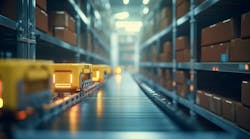Christine Lutheran is passionate about keeping counterfeit components out of supply chains. Her passion is not just about prosecuting criminals making money by injuring businesses; it's also about keeping them from causing physical injury to consumers.
She's vice president of supply chain management for Secure Components, a company that procures obsoleted parts for aerospace and government agencies whose supply chains still need the equipment these parts support. She makes sure the components she sources are legitimate and conform to standards. This is something she wishes more consumer electronics supply chains would make a priority.
Lutheran started her career in sales for consumer electronics supply chains and what she saw ignited the passion she carries to this day about phony parts reaching the homes of fellow citizens and even the hospitals responsible for their well-being.
"I was selling to a company that made defibrillators, and once I realized counterfeiting was happening in their supply chain I told them about these components that were made in China," she recalls. "I told them I wanted to test these before selling to them. They asked how much it would cost and how long it would take. Meanwhile my competitors were quoting the same stock as I, they just weren't testing. So they offered a cheaper price and a shorter lead time. I was losing business because I was trying to do the right thing. That's how I got so boisterous about this counterfeiting."
Today Lutheran deals with supply chain professionals whose jobs depend on keeping counterfeits out of products. Her company is certified to the SAE AS6081 standard, which is dedicated to helping distributors avoid, detect, mitigate and dispose of fraudulent and counterfeit electronic parts. She deals with distributors who sell electronic components from the surplus market (from sources other than the original component manufacturer or their franchised distributors).
Unlike her earlier job, Lutheran's current company is obligated to test electronic components when procured from unauthorized sources with no traceability. They must also disclose to the customer their source of supply. That way when counterfeits are discovered they get reported to that client.
"I do believe that in the end, although it might cost more to test a product, what's the cost when a counterfeit part blows up an entire circuit board?," she asks. "Now you have a larger loss you wouldn't have had if you had spent the money to test up front—or when the product gets to the consumer and they start having failures in the field."
What are the chances of that happening?
The Consequences of Fakery
In 2012, U.S. customs and border officials seized counterfeit goods worth around $1.26 billion, according to a report published by Customs and Border Protection (CBP). Think how much actually made it into consumer supply chains. Then think of the consequences. All it takes is for a substandard cable to be attached to a toaster to start a fire. Stanley Salot knows of several cases where this happened. He's president and CEO of the Center for Counterfeit Avoidance. He says it's not uncommon for counterfeiters to add Underwriters Laboratory credentials to substandard cabling—resulting in a house fire.
"The counterfeiters are ripping off the labeling and making the toaster look like it's been approved," he says. "Counterfeiting overall is now the second largest criminal activity, second only to drugs and human trafficking."
And it's growing. By 2016 counterfeiting is expected to be a $1.7 trillion industry. The supply chains in this industry are all too easy to enter, Salot adds.
"All it takes is for an entrepreneur in the U.S. to see something he thinks he can make cheaper and sell," he explains. "So they reverse engineer, send the results over to China, they build the products, bring them back, and the counterfeiting takes place by putting the original OEM's name and logo on it. It's not all China, but most of the criminal activity that's been brought to U.S. courts has been people who are American citizens. These are small entities that can make 10,000 units, sell them for hundreds of thousands or millions and then they're gone."
Standards at the Gate
The only way manufacturers can ensure their supply chains are trustworthy is to establish an assessment process based on international standards. Salot is lending his efforts to the Counterfeit Avoidance Mark Alliance, where every country would have an affiliate organization. In order to have CAMA membership you would need third party certification. This would help consumers vet the electronic products they purchase.
"The good companies undergo an annual surveillance to demonstrate they're doing what they should and we have a website and database behind that where consumers can use their smartphone to scan a barcode and see if the company is certified, their products are listed and compliant with hazardous substance restrictions like lead, cadmium, and other heavy metals. Those are tested, verified and validated to be below the safe limits for humans."
CAMA has certified more than 4500 companies worldwide. Through this program manufacturers can document how they are restricting hazardous substances from their products.
The ROI of Quality
Salot believes the costs associated with this effort are not only affordable, but result in an ROI—not only from an efficiency perspective, but from one of public relations.
"Reviewing your operations like this exposes things to improve and offset the majority if not all the costs associated with counterfeits, and actually pays back," he says. "The more contaminants or heavy metals you have the more expensive recycling is. And who's paying for the recycling? Consumers. They pay for everything and the reality is that as manufacturers take into consideration the reduction of the hazardous substances and the elimination of counterfeiting, they actually save money by becoming smarter and more efficient."
Conflict Minerals and Criminality
As of May 2014, documenting the exclusion of conflict minerals from products will keep manufacturers safe from prosecution. Beginning May 31, 2014, publicly traded companies will be required to declare to the U.S. Securities & Exchange Commission whether or not their products or components contain tin, tungsten, tantalum, or gold mined from the Democratic Republic of Congo (DRC) which is known for human rights abuses. This requirement was part of the Dodd-Frank Wall Street Reform and Consumer Protection Act.
"If you're found to be knowingly buying from sources tied into conflict minerals, the DRC stuff, you could wind up going to jail," Salot says. "Every integrated circuit made today has conflict minerals in them. Everybody from Intel to the Taiwan Semiconductor Manufacturing Company, if it's a semiconductor it has a problem. The Dodd Frank Act passed by Congress requires a reporting system and that system is now generating tons of money for consultants to help industry figure out what they're doing. It falls primarily on large corporations, but even the small ones have to do a bit of due diligence. You're dealing with a lot of unknowns when it comes to conflict minerals."
Quality: It Takes a Supply Chain
Policing product quality requires supply chain-wide vetting—meaning every link verifying their handoff.
"That has to be done vertically and horizontally," Salot adds. "That's the most cost-effective way and the most efficient for business. I work with companies that tell me they don't have time to deal with their supply chain—but they reject material constantly because it's not compliant with their requirements. Their issue is they don't have time to talk to their supply chain and verify that they're doing what they should do."
Although the conflict minerals issue has big consequences for big supply chain players at the top of the supply chain, it pales next to the consequences of counterfeits. That hits all companies, especially those closest to the sources of raw material. What's making this issue grow every year is the growth of the recycling industry. While everyone in the chain wants to reuse and reclaim, there are no standards for managing those efforts.
"A huge number of entrepreneurs have figured out they can take electronic components from manufactured goods and resell them as new after cleaning them and refurbishing," Salot says. "You have millions of components going into recycling facilities where they're disassembled, they're cleaned and made to look pretty, they're repackaged in new containers, and then they go back out on the market. Instead of me as a buyer paying 10 cents a part, I can get them for 4 cents. Since as a buyer I'm obligated to save 10% per year on everything I buy, I'm getting sucked in to buying used parts sold as if they're new and that creates a problem for consumer electronics companies. If the product is critical to life support your risk goes up."
A Matter of Life & Death
If a consumer electronic product is used on an airplane, it automatically becomes part of a giant life support system. As Salot explains it, with the airlines letting consumers provide their own on-board entertainment, if someone's device is radiating too much electromagnetic radiation it can become a health problem if his neighbor has a pace maker.
And we've already told you about Christine Lutheran's battle over defective defibrillators.
The solution to counterfeits and conflict minerals can only come through education, both at the consumer and the engineering levels.
After all, engineers are consumers too. Yet how well are these topics addressed in engineering school?
"This should be part of the engineering curriculum because reliability depends on good quality components," Salot concludes.
"Resistors, capacitors, diodes, everything you put in a machine must be quality—but what creates quality is not always taught. There's an assumption it's been taken care of. But the problem also involves procurement. They're told every year they have to save another X percent."
What might help is the installation of more Stan Salots and Christine Lutherans on the boards of education responsible for manufacturing MBAs. A solid 13-week university program addressing the difference between buying quality and buying price might help shrink the piracy problem.




